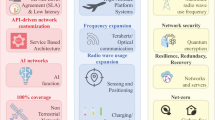Abstract
We investigate the optimal resource and power allocation for device-to-device (D2D) communications in a multicell environment. When D2D links reuse the cellular radio resources, each D2D user will interfere with a cellular link and other D2D links, in its own cell as well as in adjacent cells. We first develop a distributed resource allocation scheme that is performed by each base station independently. Then, we propose a coordinated resource allocation scheme that can handle the intercell interferences as well as the intracell interference. For a given resource allocation, we also formulate a power optimization problem and present an algorithm to find the optimal solution. The resource and power allocation algorithms are designed to maximize the achievable rate of the D2D link, while limiting the interference generated to the cellular link. The performance of the proposed algorithms is evaluated through simulations in a multicell environment. Numerical results are presented to verify the coordination gain in the resource and power allocation.







Similar content being viewed by others
Notes
We will add the leading subscript 𝓁 to indicate that the variable is associated with the 𝓁th cell.
REFERENCES
Cisco, Traffic forecast update, 2011−2016 (Feb. 2012), pp. 1–29.
M. Doppler, C. Rinne, C. Wijting, C. Ribeiro, and K. Hugl, “Device-to-device communication as an underlay to LTE-advanced networks,” IEEE Commun. Mag. 47 (12), 42−49 (2009).
C. H. Yu, K. Doppler, C. Ribeiro, and O. Tirkkonen, “Resource sharing optimization for device-to-device communication underlaying cellular networks,” IEEE Trans. Wireless Commun. 10, 2752–2763 (2011).
Huawei. Future smartphone solution white paper (Sept. 2012).
M. S. Corson, R. Laroia, J. Li, V. Park, T. Richardson, and G. Tsirtsis, “Toward proximity-aware internetworking,” IEEE Wireless Commun. 17 (6), 26–33 (2010).
Y. He, F. Wang, and J. Wu, “Resource management for device-to-device communications in heterogeneous networks using stackelberg game,” Int. J. Antennas & Propag., Article ID 395731 (2014).
3GPP TR 22.803. Feasibility study for Proximity Services (ProSe), V12.1.0. (March 2013).
3GPP TR 23.703. Study on architecture enhancements to support Proximity Services (ProSe), V0.4.1. (June 2013).
3GPP TR 36.843.Study on LTE device to device proximity services, V0.1.0. (Apr. 2013).
Q. Duong, Y. Shin, and O.-S. Shin, “Resource allocation scheme for device-to-device communications underlaying cellular networks,”in Proc. IEEE Int. Conf. on Computing, Management and Telecommunications, Ho Chi Minh City, Vietnam,2013 (IEEE, New York, 2013), pp. 66−69.
C. H. Yu, O. Tirkkonen, K. Doppler, and C. Ribeiro, “On the performance of device-to-device underlay communication with simple power control,” in Proc. IEEE Vehicular Technology Conf. Spring, Barcelona, Spain, 2009 (IEEE, New York, 2009).
C. H. Yu, O. Tirkkonen, K. Doppler, and C. Ribeiro, “Power optimization of device-to-device communication underlaying cellular communication,” in Proc. IEEE Int. Conf. on Communications, Dresden, Germany, 2009 (IEEE, New York, 2009).
P. Janis, V. Koivunen, C. Ribeiro, J. Korhonen, K. Doppler, and K. Hugl, “Interference-aware resource allocation for device-to-device radio underlaying cellular networks,” in Proc. IEEE Vehicular Technology Conf. Spring, Barcelona, Spain, 2005 (IEEE, New York, 2005).
S. Dinh-Van, Y. Shin, and O.-S. Shin, “Resource allocation and power control based on user grouping for underlay device-to-device communications in cellular networks,” Trans. on Emerging Telecommun. Technol. 28 (1) (2017).
X. Xu, H. Wang, H. Feng, and C. Xing, “Analysis of device-to-device communications with exclusive regions underlaying 5G networks,” Trans. on Emerging Telecommun. Technol. 26 (1) (2015).
B. Wang, L. Chen, X. Chen, X. Zhang, and D. Yang, “Resource allocation optimization for device-to-device communication underlaying cellular networks,” in Proc. IEEE Vehicular Technology Conf. Spring, Budapest, Hungary, 2011 (IEEE, New York, 2011).
J. Liu, B. Li, B. Lan, and J. Chang, “A resource reuse scheme of D2D communication underlaying LTE network with intercell interference,” Commun. and Network 5 (3B),187−193 (2013).
G.-M. Kang and O.-S. Shin, “Mode selection and resource allocation for device-to-device communications in cellular networks,” Information A 17, 2423−2436 (2014).
K. Kim, Y. Han, and S. Kim, “Joint subcarrier and power allocation in uplink OFDMA systems,” IEEE Commun. Lett. 9, 526–528 (2005).
D. P. Bertsekas, Nonlinear Programming, 2nd Ed. (Scientific, Athena, 1999).
ACKNOWLEDGMENTS
This work was supported by the National Research Foundation of Korea (NRF) grant funded by the Korean government (MSIT) (no. 2019R1A2C1084834).
Author information
Authors and Affiliations
Corresponding authors
Rights and permissions
About this article
Cite this article
Gil-Mo Kang, Oh-Soon Shin Resource and Power Allocation for OFDM-Based Device-to-Device Communications in a Multicell Environment. J. Commun. Technol. Electron. 65, 532–540 (2020). https://doi.org/10.1134/S1064226920050083
Received:
Revised:
Accepted:
Published:
Issue Date:
DOI: https://doi.org/10.1134/S1064226920050083




